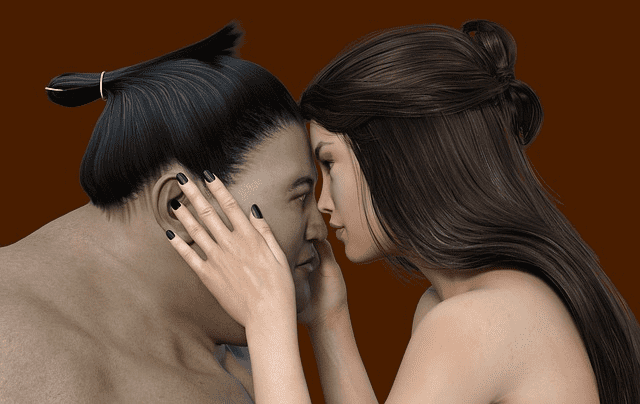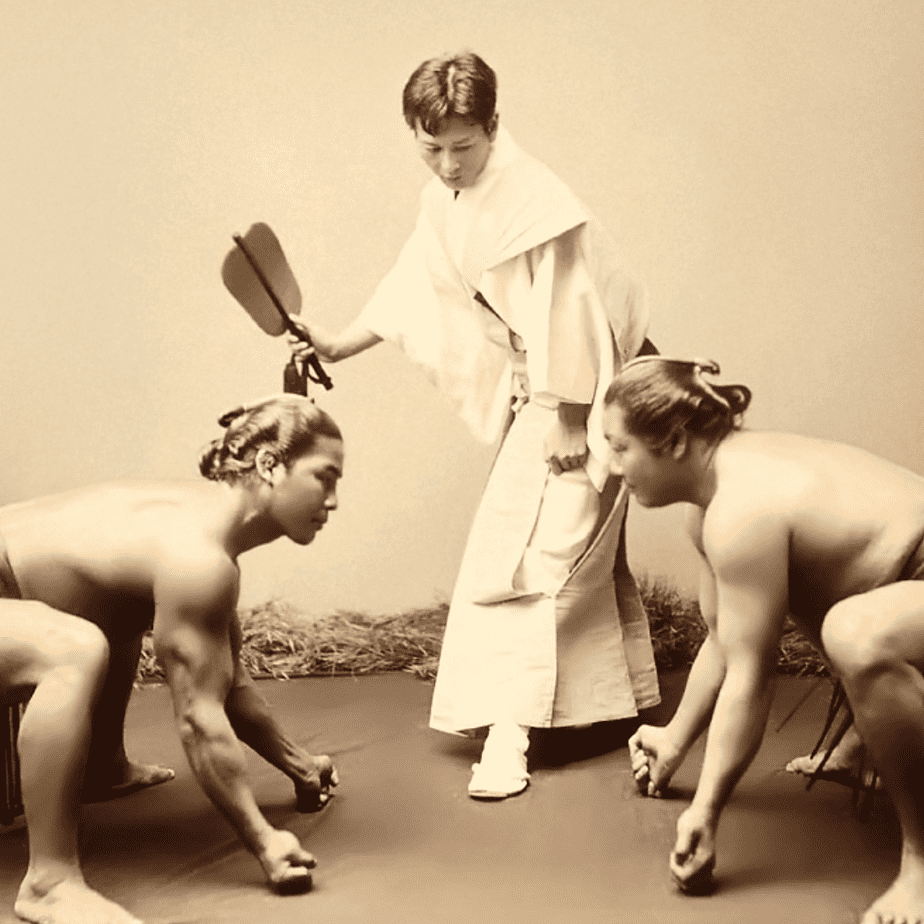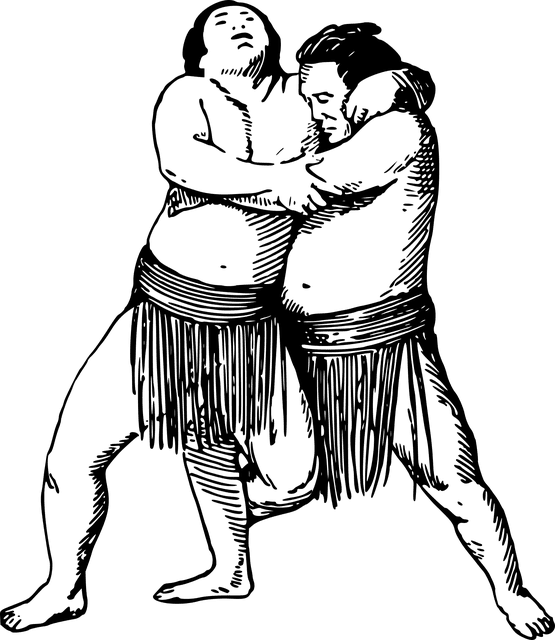
Sumo is a style of full-contact wrestling bout, where your goal is to push your opponent (sumo wrestler, rikishi) out of the Sumo ring or to force him to touch the ground with any body part other than the soles of his feet.
Sumo was created in Japan, where professional sumo is also considered Japan’s national sport. Nowadays, there are many traditional elements in sumo, for example, salt purification.
The lives of professional sumo wrestlers are followed by the strict ruleset, which is issued by the Japan Sumo Association. Wrestlers live in a communal sumo training stable, where every single second of their days is perfectly planned. And yes, weight gain matters a lot!
This article will focus on the Sumo grand champion, history, ranking hierarchy, tournaments, and the elements of this sport outside of Japan (mostly in Hawaii). Let’s get to know this specific style of hand to hand combat!
Etymology
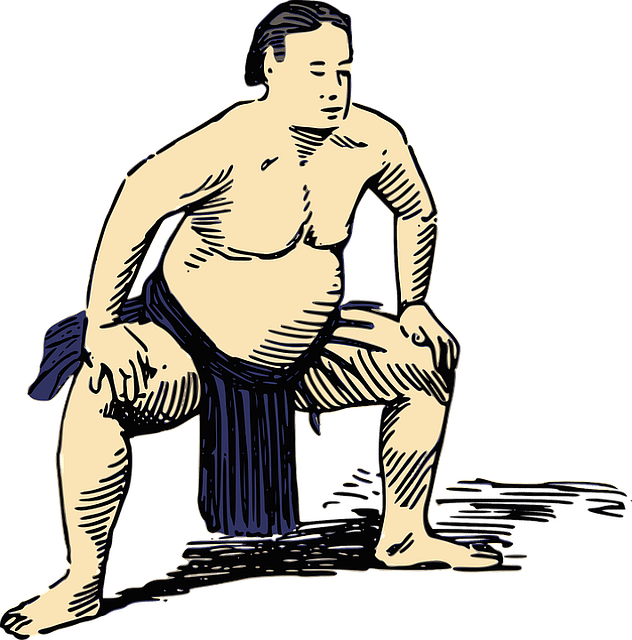
Who Are Professional Sumo Wrestlers
The word sumo refers to the verb sumau/sumafu, which means “compete” or “fight”. It is a part of the expression sumai no sechi (相撲の節), a competition from the Heian period.
The characters from sumai, or sumō today, mean “to strike each other”. In Japan, the word sumo means “to wrestle” or “wrestling”. For example, the term for the sport of Japan Sumo Association is ōzumō (大相撲), or, in literal translation, “grand Sumo”.
History of Sumo Wrestling
Some prehistoric paintings allude that Sumo originates from an agricultural dance in the honor of the good harvest.
The first mention of this word happened in 712 when the legendary possession of Japanese islands was decided in a bout between Takemikazuchi (God of thunder, swordsmanship, and conquest) and Takeminakata (God of water, hunting, wind, and agriculture), where Takemikazuchi won in a hand to hand combat.
The first sumo bout between mortals happened back in 23 BC when Nomi no Sukune eventually killed Taima no Kuehaya in a bout, which makes him the mythological ancestor of the sport trademarked by the circular ring. Until the Japanese Middle Ages, these were unregulated bouts where the combatants fought to the death.
Japanese Middle Ages (1185–1603)
The Kamakura period is the golden age of Sumo, as it was repurposed from a pure ceremonial martial art to samurai military training combat. The popularity started to grow, and by the Muromachi period, it became an event for the masses, there were even sponsors for rikishi wrestlers.
The Sumotori who participated in the bouts were getting Samurai status and general support. The first big event was held by Oda Nobunaga, who created a lovely Sumo tour for 1,500 people in 1578.
The circular ring appeared for the first time in those events, but its primary purpose was to maintain the safety of spectators and to hasten the proceedings. Yet, a circular ring comes from Nobunaga’s Sumo tournament.
Edo Period (1603–1867)
There were many wild street fights during the Edo period, so Sumo was temporarily banned, but the restriction was removed in 1684, and it was allowed for charity events on the properties of Shrinto shines.
The first-ever sanctioned Sumo tournament took place in Tomioka Hachimangu Shrine, plus the first organization of professional wrestlers was created. There were many great fighters from this period. For example, the first Yokozuna in history, Tanikaze Kajinosuke, lived in the 18th century.
Since 1868
The era of the feudal system and rich sponsors ended in 1868 with the Meiji restoration. Sumo had come to be seen as an embarrassing activity because of the western influence, which led to internal disputes in the central association.
Yet, Emperor Meiji created a tournament for wrestlers in 1884, which restored the popularity of this discipline. Thanks to his influence and military win over Korea and China, Sumo became the national symbol.
Finally, the Japanese Sumo Association reunited in December 1925. It increased the number of annual tournaments to four. In 1958, there were six major tournaments in one year. In 1949, the professional wrestling tournament length was changed from 10 days to 15 days.
Is Sumo Wrestling A Sport?
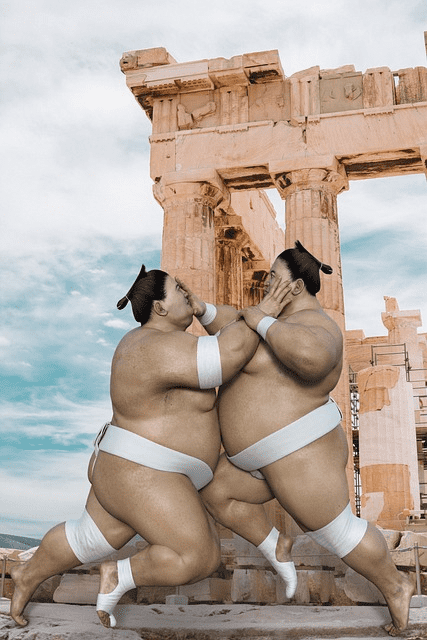
Sumos: What Is And Wrestlers
Of course, every bout offers a strict rule set that mustn’t be broken. Most sumo wrestlers compete in the ring, with no strikes to the crotch area or any other illegal moves. This is not a street bout, you will get disqualified if you break the rules or intentionally walk out of the ring.
The rikishi who wins the tournament gets a lot of attention and earns a spot in history. Sumo tournaments winners gain a lot of respect.
When Did Sumo Become A Sport?
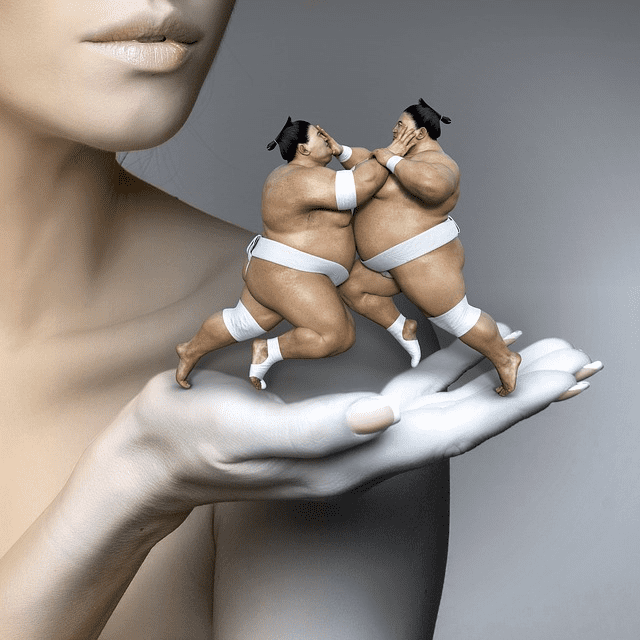
Sumo: What is and Wrestlers
Sumo evolved through many centuries, but the first professional wrestlers appeared sometime during the Edo period (1603 – 1867). This age brought paid fighters who got money and other gifts to fight. Professional Sumo is a Japanese national sport nowadays.
Why Is Sumo Not An Olympic Sport?
There aren’t enough international Sumo Federations in different states, so professional Sumo wrestlers cannot make IOC take notice and consider Japan’s national sport as a potential Olympic discipline. Japan Sumo Association exists in the “state of the Rising Sun”, but how many federations in the sumo world can you name?
Are Sumo Wrestlers Considered Athletes?
Absolutely yes, Sumo is one of the hardest martial arts in the world. Many consider competitors in Sumo tournaments obese, but they live a very hard life and dedicate every single day to their training sessions. Even lower ranked wrestlers have a very busy schedule.
They have high physical activity levels despite being obese, and they suffer an increased risk of hypertension, hyperlipidemia, and glucose intolerance because of their size.
Rules And Customs
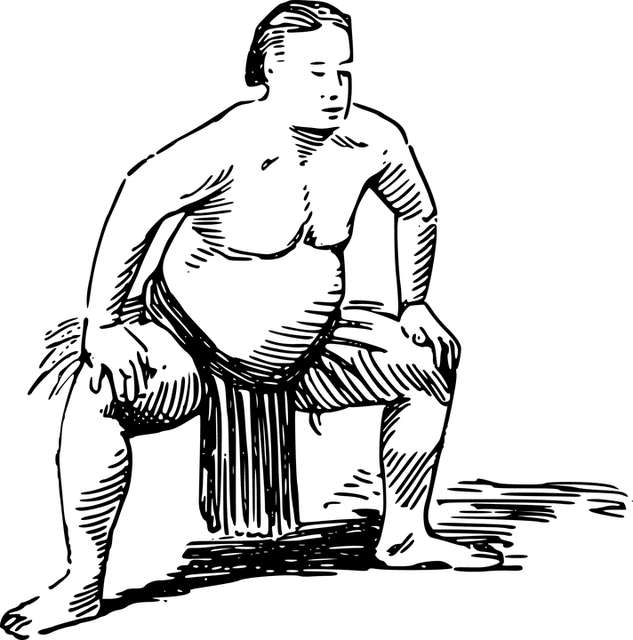
There are no weight divisions in this discipline. Thanks to no weight classes, you will see a huge guy fighting a smaller opponent many times – it is normal in the tournament. The heaviest wrestler in the world might square off against a guy who weighs less than 200 pounds.
Dohyo-iri are ring entering ceremonies, which are performed only by wrestlers in juryo and makiuchi divisions (west and east sides perform it together), while every yokozuna (top division combatant) has his individual dohyo-iri, performed separately.
The upcoming paragraphs will explain all the secrets of rikishi in tournaments, and bouts, and get to know you with the list of prohibited and legal moves in a Sumo bout.
Sumo Rules
The ultimate goal of the Sumo bout is to force their opponent out of the ring or to make him touch the clay surface with any part of his body other than the soles of the feet. That’s why bouts between sumo wrestlers sometimes last only a few seconds.
If any part of the wrestler’s body, even the tip of a finger, touches the ground or the outside of the straw bales marking the ring circle he loses the bout. When both wrestlers fly out of the ring, the one who touched the ground first loses the combat.
You are allowed to slap, push, trip, and flip your opponent. Yet, kicking, striking with fists, hair pulling, eye-gouging, grabbing vital organs, and choking are illegal. Those maneuvers are not winning techniques, they are penalties. You are also allowed to grab any part of the opponent’s body, even the neck, plus the contact with a mawashi belt is perfectly legal too.
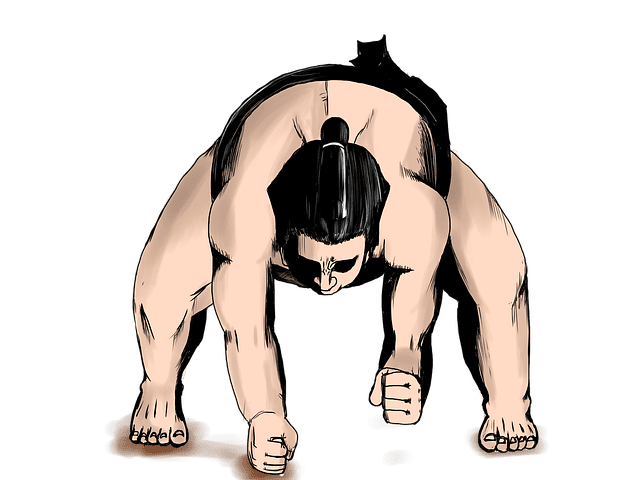
Sumos: What Is And Wrestlers
Sumo Wrestler’s Belt
The wrestlers fight barefoot, wearing a “mawashi”, the distinctive wrestler’s loincloth-like belt. It is 2 feet wide and 10 meters long, folded sideways six times and wrapped around the waist four to seven times. The belt is attached around the groin with a strap.
Sometimes wrestlers wet or loosen their mawashi because it turns them into a harder target for their opponents. There are over 70 Sumo techniques involving the mawashi belt. The chords dangling from the front of the belt are made of silk stiffened with glue and are purely ornamental. They might become detached during the bout.
Sumo Match
The bout kicks off with a “taich-ai”, or initial charge, both wrestlers are in crouching positions, hands in a fist, staring down at each other. When ready, ring warriors touch the knuckles of both hands on the ground and charge.
If one wrestler jumps the gun, the ref calls for a new start and the rule breaker bows to his opponent and apologizes. Sometimes, the combatants didn’t touch the dirt with both hands, but it changed in 2008 when the Japan Sumo Association insisted that both fighters must do that. Judges are also instructed to rigorously enforce the rule.
The average length of the Sumo bout is a few seconds unless you are Akebono and Takanohana (that match lasted more than one minute).
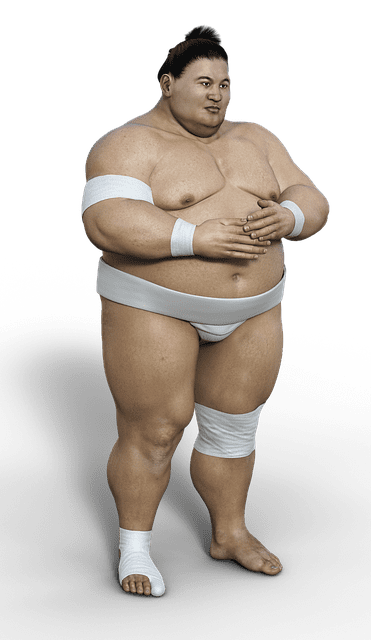
Sumos: What Is And Wrestlers
Sumo Technique
There are over 70 different moves that can be used to throw your opponent out of the ring or to bring him down to the ground. There are 48 recognized sumo techniques. They are known under the syntax “beltless arm throw” or “one leg trip.”
The fight usually kicks off with ferocious slapping, then fighters grab each other in the clinch. Some wrestlers rather try to push their opponent out of the ring, while others are mawashi men known for belt throws.
Smaller sumo wrestlers in the Japanese Sumo Association usually go for a side step, then push their foes out of the ring via quickness, explosiveness, and low center of gravity, thanks to their superior technique.
Sumo Ring
The bouts take place on a “dohyo”, an 18-foot square and two-foot-high platform, which is made of a special kind of clay to prevent fighters from injuries (Japanese version of the ring).
The professional wrestlers battle each other within a 15-foot-in-diameter ring. It is encircled with twisted rice straw, plus covered with a layer of sand, which allows sliding.
We’ve got a Shinto shrine hanging over the dohyo, suspended from the ceiling by cables. You can see four giant tassels hanging from each corner (they signify the seasons of the year – spring, summer, autumn, and winter).
Women are not allowed to step on the dohyo (ring) and all Shinto shrines because they are considered ‘unclean’ when in a menstrual cycle. For example, a female governor of Osaka wanted to represent a tournament in the past, but a man was sent instead of her due to the old traditions.
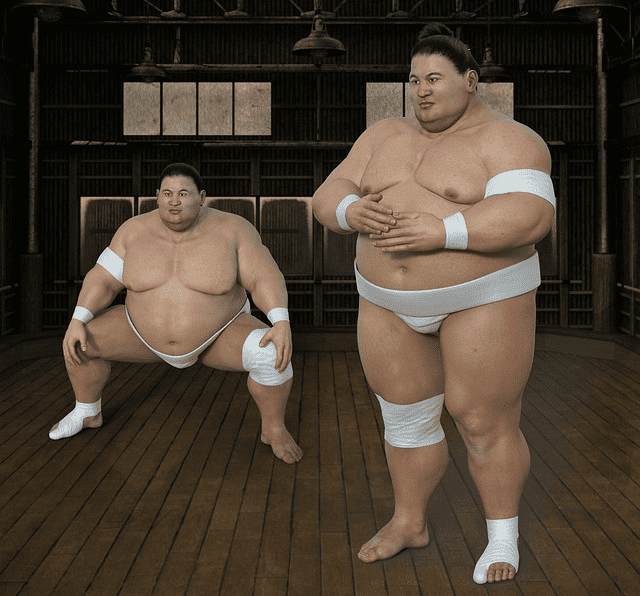
Sumos: What Is And Wrestlers
Sumo Judges
Judges are former Sumo champs that ratify the referee’s decisions and hold special conferences to decide close bouts. They sit at ringside seats in black kimonos.
There are no cameras for instant replay, but judges can sometimes take a look at the footmarks and impressions in the dirt before making a final decision. The ref’s decision can be reversed, or a rematch can be called when the two sumo wrestlers participated in a very close bout.
End of Sumo Match And Bow Twirling
The wrestlers and fans never complain about the decision of the referee, it is final. The competitors must accept victories and defeats with equally dispassionate stoicism, but sometimes you can see different expressions on their faces.
The loser immediately exits the ring, and the winner hangs around, drinks some water, squats, and gets recognized as a winner by the ref.
Every day of the Sumo tournament ends with the “bow match,” in which specially-picked wrestlers climb into the dohyo and are handed a bow by the gyoji. The wrestler twirls the bow around like a baton. This ritual dates back to the Edo period in Japan.
The bow twirling at the end of the matches is traditionally done by low ranked wrestlers, but the bow twirler should come from the stable of Yokozuna. Yet, sometimes there is no suitable candidate.
Professional Sumo Divisions
There are six divisions in Sumo: Makuuchi (fixed at 42 wrestlers), Juryo (fixed at 28 wrestlers), Makushita (fixed at 120 wrestlers), Sandanme (fixed at 200 wrestlers), Jonidan (approximately 230 wrestlers), and Jonokuchi (approximately 80 wrestlers).
You start from the lowest ranking, then work your way up to the top, the Makuuchi division. Unfortunately, only the first two top division fighters get salaries, that’s why everybody fishes for the highest rank ASAP.
Professional Sumo Tournaments

There are large six tournaments supported by Japan Sumo Association every year since 1958: three at the Ryōgoku Kokugikan in Ryōgoku, Tokyo (January, May, and September), and one each in Osaka (March), Nagoya (July), and Fukuoka (November).
There are no large consecutive tournaments or back-to-back significant events in the capital of Japan. Every single tour kicks off on Sunday, and lasts for 15 days, also ending on Sunday. A great piece of opportunity for tournament ticket holders to earn some money. Sumo tickets are not cheap at all!
An Important Sumo Wrestler: Akebono Tarō
Akebono Taro is an American-born former professional Sumo competitor from Waimanalo, Hawaii. He is the first-ever non-Japanese rikishi who reached the yokozuna level in history thanks to his outstanding performance.
Early Life
Akebono was born on 8 May 1969 to Randolph and Janice Rowan and grew up with two brothers. He was a basketball player who quit his career to pursue his dream.
Sumo Career
Akebono flew to Japan in 1988 to kick off his Sumo run, and he adopted the name of “Akebono”, which means “rising sun”.
His rise in the career was stunning, he reached juryo in March 1990, and makuuchi in September the same year. Taro also earned the first gold star in 1991 after defeating yokozuna Asahifuji.
Promotion
Akebono was promoted to ozeki in 1992 thanks to his great achievements and consecutive wins. After consecutive championship wins, he was promoted to yokozuna in 1993, the first-ever from his stable.
Yokozuna Era
Akebono won many great tournaments, he was a long-standing and strong yokozuna. He beat Takanohana and Wakanohana in 1993, and won many great tournament championship bouts in the years to come.
Unfortunately, he was very prone to injuries due to his size and weight. He also got the honor to represent Japan in the opening ceremony of Winter Olympics in Nagano, Japan, 1998.
Fighting Style
He was one of the tallest and the most ferocious sumo combatants in history. Despite long legs, which were considered bad in this sport, he trained very hard and used his reach to push his foes out of the ring. Akebono mastered tsuparri techniques.
Retirement
Akebono suffered another injury after winning the eleventh top division title in 2000 and retired in 2001. Later he became a member of the Japan sumo association as a coach.
What Is Akebono Real Name?
The birth name of the legend who reached the highest rank in top division is Chadwick Haheo Rowan.
Japanese Wrestlers
Sumo wrestlers from Japan are the most popular in the sport of Sumo in Japan. They are very disciplined and ready to follow the strict rule set.
Japan Sumo Association
Established in 1925, the JSA is not just an organization; it’s the heartbeat of professional sumo wrestling in Japan. Operating under the watchful eye of the Japanese Ministry of Education, Culture, Sports, Science and Technology, they are responsible for most sumo matches and sumo events.
The Epicenter of Sumo Tradition
The JSA is a tapestry woven with tradition, discipline, and the thunderous clashes of sumo titans. It’s where the raw power of sumo wrestlers, known as ‘rikishi,’ meets the strategic finesse of this centuries-old sport. The association oversees the organization of official tournaments, known as ‘honbasho,’ and the promotion of sumo culture, ensuring that the sport’s rich heritage continues to thrive in modern times.
More Than Just Muscle and Might
The JSA’s role extends beyond organizing the clash of sumo giants. It’s also responsible for nurturing the next generation of sumo talent. Through its Sumo School, the association provides rigorous training and instruction, shaping young aspirants into sumo warriors who might one day dominate the dohyo (sumo ring). The Sumo Museum, another feather in the JSA’s cap, preserves and showcases the sport’s history, making it a treasure trove for sumo enthusiasts.
A Symphony of Tradition and Modernity
The JSA is a fascinating blend of ancient rituals and modern governance in the sumo hierarchy. It’s an organization where retired wrestlers, known as ‘oyakata,’ wield the gavel, steering the sport with wisdom gleaned from years in the ring. These elders are the custodians of sumo’s legacy, ensuring that every slap of the hand and stomp of the foot resonates with centuries of tradition.
The Japan Sumo Association is not just an organization; it’s a living, breathing embodiment of sumo itself. It’s where tradition meets the present, where the echoes of ancient sumo rituals blend seamlessly with the needs of the modern sport. For anyone enchanted by the world of sumo, the JSA is the guiding light, the keeper of the sumo flame.
What Do Sumo Wrestlers Eat?
The diet of a sumo wrestler, a figure of immense strength and size in the world of traditional Japanese wrestling, is as fascinating as it is unique. These athletes follow a meticulously planned diet, designed to maintain their extraordinary weight and strength, crucial for their success in the ring. Apart from winning technique they need to eat the right staple food, especially around the time of their next tournament.
The Sumo Wrestler’s Diet: A Caloric Powerhouse
Sumo wrestlers typically consume between 3,000 to 5,000 calories per day, a staggering amount compared to the average person’s intake. This high-calorie diet is essential for sustaining their massive physique and the strength required for sumo wrestling.
The Core of the Diet: Chanko Nabe
At the heart of a sumo wrestler’s diet is ‘chanko nabe,’ a traditional Japanese stew. This dish is a sumo staple, packed with a variety of ingredients like vegetables, seafood, and meat, providing a balanced mix of nutrients. Chanko nabe is usually accompanied by rice and other side dishes, making it a filling and nutritious meal.
High-Protein and High-Calorie Foods
In addition to chanko nabe, sumo wrestlers’ diets include a variety of other high-calorie and high-protein foods. Grilled meats, tofu, and eggs are common, offering the necessary protein for muscle repair and growth. Fluid intake is also crucial, with wrestlers consuming plenty of water, milk, and sports drinks to stay hydrated and nourished.
The Discipline Behind the Diet
Adhering to such a diet along with regular intense training session requires immense discipline. Sumo wrestlers must carefully plan and prepare their meals to ensure they get the right balance of calories and nutrients. Regular exercise and training are also integral to building muscle mass and maintaining their formidable shape.
The Health Benefits
Despite its extremity, the sumo diet, rooted in traditional Japanese eating habits, is believed to offer health benefits, including improved heart health and potential cancer prevention. It’s a diet crafted to fuel the rigorous training schedules of sumo wrestlers, supporting their impressive physiques and the demands of their sport.
An Increasing Number Of Foreign Sumo Wrestlers
After Akebono, the number of foreign wrestlers significantly grew. Many foreign wrestlers fly to Japan and even reach the status of yokozuna or at least compete in the second division.
Four American Wrestlers in Japan
There are four very popular names who left a great trail in Sumo:
- Takamiyama – strength and momentum expert;
- Konishiki – three-time championship winner, close to yokozuna;
- Akebono – long-lasting yokozuna;
- Musashimaru – the first-ever yokozuna from American Samoa.
Hawaii Sumo Wrestlers: What Are Hawaiian Wrestlers Called?
Same name like in Japan, rikishi. The most famous names are Akebono, Takamiyama, and Konishiki.
Chinese Sumo Wrestlers
Sokokurai Eikichi (born Enkhtuvshin in 1984) comes from Inner Mongolia, China. He is the only Sumo fighter from China to reach the top of the makuuchi division in Japan.
Women And Sumo
Unfortunately, Sumo competitions are not allowed in Japan due to traditional values, it is prohibited at a professional level, but its amateur shape exists.
The International Sumo Federation allows female competitions. There was a Sumo event for females in Combat Games in 2013. The first national championship was held in 1997, with two differences – females wear leotards under mawashi, and one bout lasts three instead of five minutes.
Some of the notable names from female Sumo world are Hiyori Kon, Miki Satoyama, Sharran Alexander, Julia Dorny, Hetal Dave, Edyta Witkowska, and others.
